Antelope Island is a natural and beautiful island escape on the Great Salt Lake in Utah. Home to various kinds of wildlife, the island is a perfect destination for avid bird watchers.
From tiny warblers to majestic eagles, birds find refuge in the island’s diverse habitats, such as grassy fields, wooded areas, and sandy beaches. The island’s natural environment is pristine, making it an idyllic spot for birds to rest and nest.
With over 250 species of birds recorded on the island, including some rare ones, Antelope Island’s bird population is a sight.
Whether you’re an experienced birder or just a curious traveler, Antelope Island is a must-visit destination to witness the beauty and diversity of the island’s birds.
24 Antelope Island Birds You Didn’t Know
Antelope Island is a state park in Utah home to a diverse and rich birdlife. The island is surrounded by the Great Salt Lake, which provides a habitat for many waterfowl and shorebirds. The island also has grasslands, wetlands, and mountains that attract other bird species.
We will introduce you to 24 Antelope Island birds you may not have heard of before. These birds are rare, endangered, or have unique features that make them stand out.
1. Golden Eagle
The Golden Eagle is an iconic bird of prey found throughout the northern hemisphere. It is a large, powerful raptor with dark brown feathers and lighter golden-brown plumage on its nape.
Immature eagles have white patches around their beaks, tails, and wings, which they lose as they mature.
Its diet consists mostly of small mammals such as rabbits, hares, and marmots but can also include birds or reptiles, depending on where it lives.
These majestic creatures are known for their remarkable strength in flight, using thermal updrafts to soar high into the sky, searching for food, or simply enjoying the view below them.
They are often seen soaring alone over open expanses, looking out for potential threats from other predators like wolves or foxes that may encroach upon their territory.
Scientific classification:
| Kingdom | Animalia |
| Phylum | Chordata |
| Class | Aves |
| Order | Accipitriformes |
| Family | Accipitridae |
| Genus | Aquila |
| Species | A. chrysaetos |
Also Featured In: Most Common Birds in China, Native Birds of Kazakhstan
2. Western Meadowlark
The western meadowlark is a medium-sized icterid bird native to North America. It has a distinct yellow breast with black and white patches, making it easy to spot in open grasslands.
Its diet consists mostly of bugs but also includes seeds and berries. The western meadowlark’s call is unique – its sound is flute-like or watery, differentiating it from the similar eastern meadowlark species.
When the nesting season arrives, they build their nests on the ground near shrubs or low trees in areas like fields and pastures.
This beautiful songbird adds life to our open lands with its melodious tunes.
Scientific classification:
| Kingdom | Animalia |
| Phylum | Chordata |
| Class | Aves |
| Order | Passeriformes |
| Family | Icteridae |
| Genus | Sturnella |
| Species | S. neglecta |
Also Featured In: Most Common United States Birds, Most Common Songs Birds that Live around You
3. Bald Eagle
The majestic Bald Eagle is a bird of prey found in North America and recognized as the national symbol of the United States.
With its distinctive white head, brown body, and striking yellow beak, this sea eagle has two known subspecies that form a species pair with the White-tailed Eagle.
It inhabits much of Canada, Alaska, all states in the US, contiguous area, and Northern Mexico near large bodies of water where they feed mainly on fish.
These birds have an impressive wingspan ranging from 1.8 to 2 meters depending on their size, making them one of nature’s most magnificent creatures.
Scientific classification:
| Kingdom | Animalia |
| Phylum | Chordata |
| Class | Aves |
| Order | Accipitriformes |
| Family | Accipitridae |
| Genus | Haliaeetus |
| Species | H. leucocephalus |
Also Featured In: Birds Live in Arkansas, Flight Birds You Should Know
4. Common Starling

The Common Starling is a medium-sized passerine bird that belongs to the Starling family. It has glossy black plumage with a metallic sheen, and at certain times of the year, it can be speckled with white.
The bill and legs are typically pink or black depending on the season, while its length measures about 8 inches long.
Its diet consists mainly of insects but includes small fruits, seeds, and human food waste.
They live in large flocks, which protects predators, although they can become quite aggressive when defending their nesting sites during breeding seasons.
Overall, this species is highly adaptable and widely distributed across many parts of Europe, making them one of the most successful birds in the region today.
Scientific classification:
| Kingdom | Animalia |
| Phylum | Chordata |
| Class | Aves |
| Order | Passeriformes |
| Family | Sturnidae |
| Genus | Sturnus |
| Species | S. vulgaris |
Also Featured In: Most Common Winter Birds, Flocks Birds around Us
5. California Gull
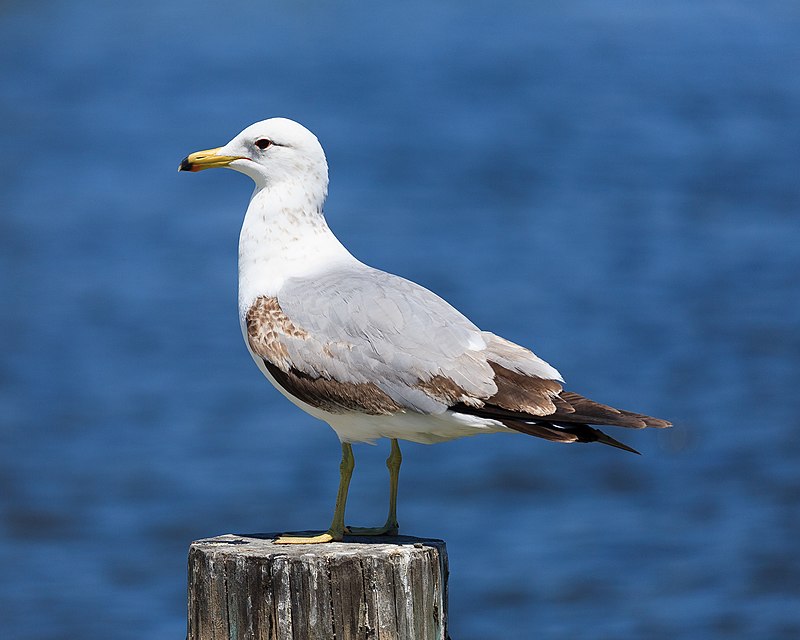
The California Gull is a medium-sized bird, smaller than the herring gull but larger than the ring-billed gull. It has a yellow bill with a black ring and yellow legs.
Its head is rounder than other gulls, and its body is mainly white with grey back and wings.
They are mostly found around lakes, rivers, or coasts of western North America, where plenty of food, such as fish, insects, and crustaceans, is available for them, which they consume daily.
During the breeding season, these birds form large colonies near water bodies or wetlands, making their nests using grasses, sticks, or feathers.
As omnivores, they play an important role in maintaining balance within local ecosystems by eating plant material like seeds & fruits as well as small mammals like rodents.
Scientific classification:
| Kingdom | Animalia |
| Phylum | Chordata |
| Class | Aves |
| Order | Charadriiformes |
| Family | Laridae |
| Genus | Larus |
| Species | L. californicus |
Also Featured In: Birds that Live in San Francisco Bay Area, Lake Tahoe Birds
6. Red-Winged Blackbird

The red-winged blackbird is a beautiful bird found in most of North America and Central America.
Its distinct features include a glossy black body, white shoulder patches, and bright red wing coverts year round.
It prefers wetland habitats such as marshes, ponds, lakeshores, and agricultural fields. During breeding season, they inhabit grassy areas near water, then move south for the winter months.
For food, they mainly eat insects but also consume wild fruit or grains.
They are very social birds, often seen in large flocks during migration when their unmistakable “conk-la-ree” call can be heard echoing across the sky.
Scientific classification:
| Kingdom | Animalia |
| Phylum | Chordata |
| Class | Aves |
| Order | Passeriformes |
| Family | Icteridae |
| Genus | Agelaius |
| Species | A. phoeniceus |
Also Featured In: Birds Commonly Found in New York, New Hampshire Birds You Should Know
7. American Avocet
The American Avocet is a stunningly beautiful bird found in North America. With its striking black and white plumage, long blue legs, and upturned bill, it is an unmistakable sight.
It spends much time foraging around shallow water or mud flats, searching for crustaceans and insects to feed on by sweeping its beak from side to side through the water.
The German naturalist Johann Friedr formally described this species back in 1789 as Recurvirostra americana – aptly named due to their habit of recurving their bills when feeding.
These graceful wading birds are truly a marvel of nature that deserves our admiration.
Scientific classification:
| Kingdom | Animalia |
| Phylum | Chordata |
| Class | Aves |
| Order | Charadriiformes |
| Family | Recurvirostridae |
| Genus | Recurvirostra |
| Species | R. americana |
Also Featured In: Most Popular Bird Species in North America, Birds that Live around Central Florida
8. American Wigeon
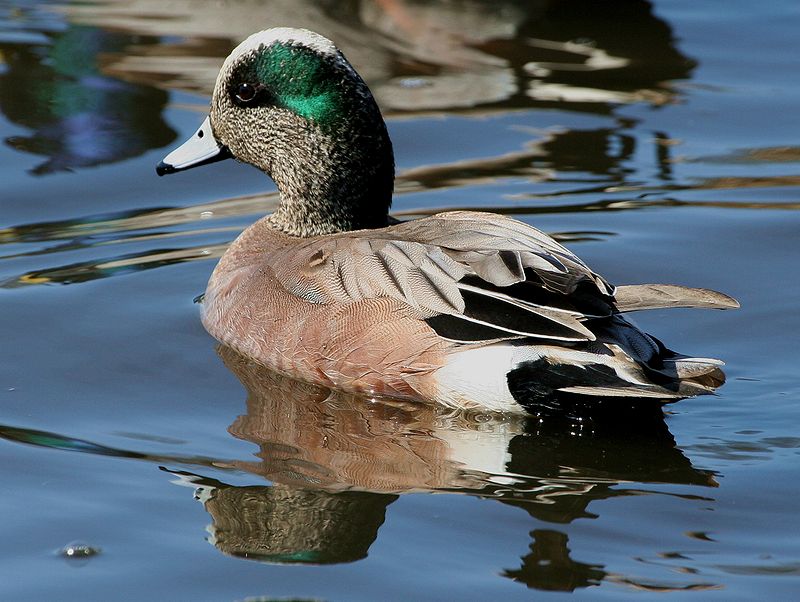
The American Wigeon, also known as the Baldpate, is a species of dabbling duck found throughout North America.
It closely resembles its Eurasian counterpart and was formally described in 1789 by German naturalist Johann Friedrich Gmelin.
This medium-sized bird has an overall grey body with white feathers on its face and belly, giving it a distinctive bald appearance.
Its wings are brownish black with green speculum markings, while the tail is dark brown or black at the base and gradually lightens near the tips to become chestnut-colored.
The male wigeons have purple patches on their heads during the breeding season and yellow eyes, which helps differentiate them from females, who have duller colors around their faces instead of bright ones like males.
Scientific classification:
| Kingdom | Animalia |
| Phylum | Chordata |
| Class | Aves |
| Order | Anseriformes |
| Family | Anatidae |
| Genus | Mareca |
| Species | M. americana |
Also Featured In: Water Birds Live around Us, British Columbian Birds
9. American White Pelican
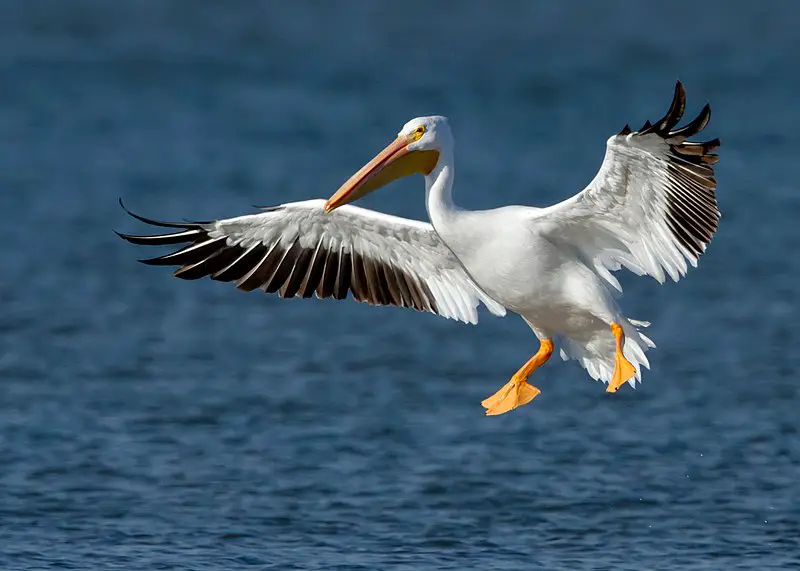
The American White Pelican is a majestic bird from the Pelecaniformes order, known for its impressive size and ability to soar gracefully in the sky.
It breeds during summer months in North America and migrates southwards towards Central and South America during winter.
The species was first described by German naturalist Johann Friedrich Gmelin back in 1789 as part of his updated version of Carl Linnaeus’ work.
This large aquatic bird has an all-white plumage with black primary flight feathers on its wings, while its beak features a characteristic yellowish coloration at the base near the face.
Its diet mainly consists of fish which it typically catches after dipping into water using its long bill; yet sometimes they can be seen stealing food items from other birds such as cormorants or gulls.
Scientific classification:
| Kingdom | Animalia |
| Phylum | Chordata |
| Class | Aves |
| Order | Pelecaniformes |
| Family | Pelecanidae |
| Genus | Pelecanus |
| Species | P. erythrorhynchos |
Also Featured In: Birds You’ll Find in South Texas , Birds that Migrate through Illinois in the Spring
10. Great Horned Owl
The Great Horned Owl is an impressive bird native to the Americas. It is well-known for its wide range and adaptability, as it can be found in many habitats across the continent.
Its diet consists primarily of rabbits, hares, rats, and mice; however, it also consumes skunks, geese, and other birds.
With their powerful talons capable of easily crushing prey, these owls have earned themselves a fearsome reputation due to their incredible strength.
Their iconic horn-like tufts on either side of their head add another layer of intimidation, which helps them stand out from other owls in the area.
Scientific classification:
| Kingdom | Animalia |
| Phylum | Chordata |
| Class | Aves |
| Order | Strigiformes |
| Family | Strigidae |
| Genus | Bubo |
| Species | B. virginianus |
Also Featured In: Common Southern Californian Birds, Birds You’ll Find in Zoo
11. Chukar
Chukar is a Palearctic upland gamebird belonging to the pheasant family. It has distinctive black and white bars on its flanks, brown upperparts, and buff underparts.
Its head is grey with an off-white face, throat, and crest, which turns chestnut in males during breeding season.
The Chukar typically lives in dry regions like open terrain or semi-arid hillsides, feeding mainly on seeds and invertebrates.
During winter, they tend to inhabit more wooded areas, seeking shelter from harsh winds or snow storms.
They are social birds living in groups of up to 20 individuals but will pair off when mating season arrives.
Scientific classification:
| Kingdom | Animalia |
| Phylum | Chordata |
| Class | Aves |
| Order | Galliformes |
| Family | Phasianidae |
| Genus | Alectoris |
| Species | A. chukar |
Also Featured In: Native Pakistani Birds, Birds That Live in Iraq
12. Burrowing Owl
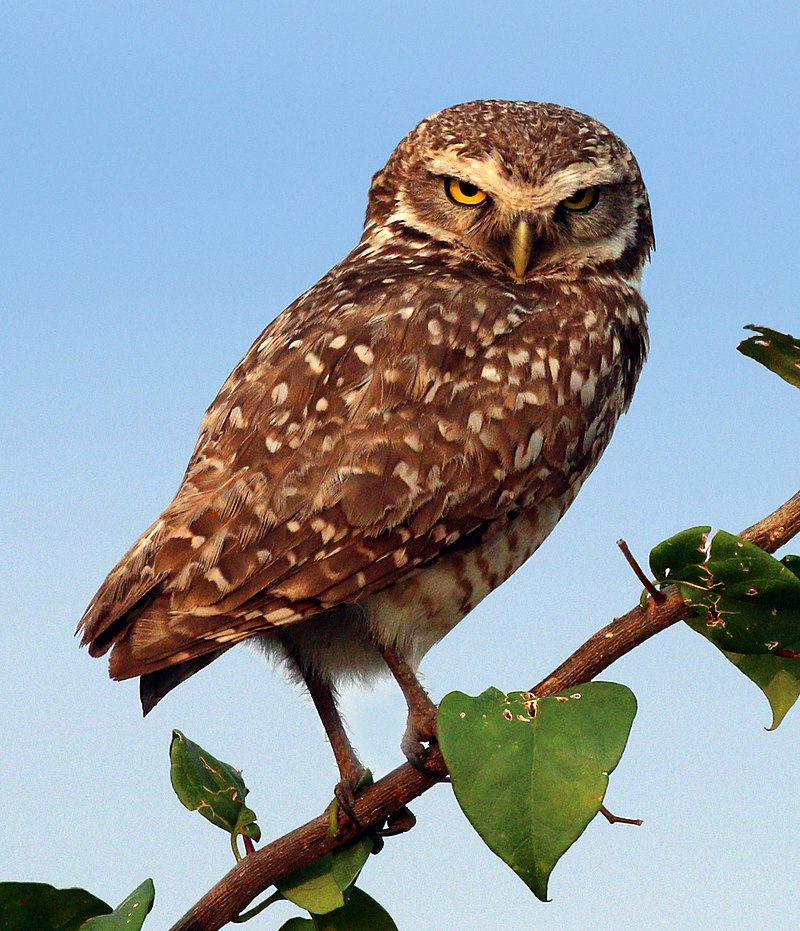
The Burrowing Owl is a small, long-legged owl found in open landscapes throughout North and South America. They are typically seen in grasslands, rangelands, agricultural areas, or deserts with low vegetation.
Unlike most owls, they nest and roost underground by taking over burrows made by other animals, such as prairie dogs.
Their diet consists of insects, rodents, and sometimes lizards or frogs that they hunt during the nighttime hours when their eyesight is sharpest.
This species faces threats due to habitat loss caused by human development, but conservation efforts have been successful at reversing some of this damage, allowing for populations to remain stable into the future despite these pressures.
Scientific classification:
| Kingdom | Animalia |
| Phylum | Chordata |
| Class | Aves |
| Order | Strigiformes |
| Family | Strigidae |
| Genus | Athene |
| Species | A. cunicularia |
Also Featured In: Beautiful Brazilian Birds, Birds that Live around Southwest Florida
13. Black-Necked Stilt
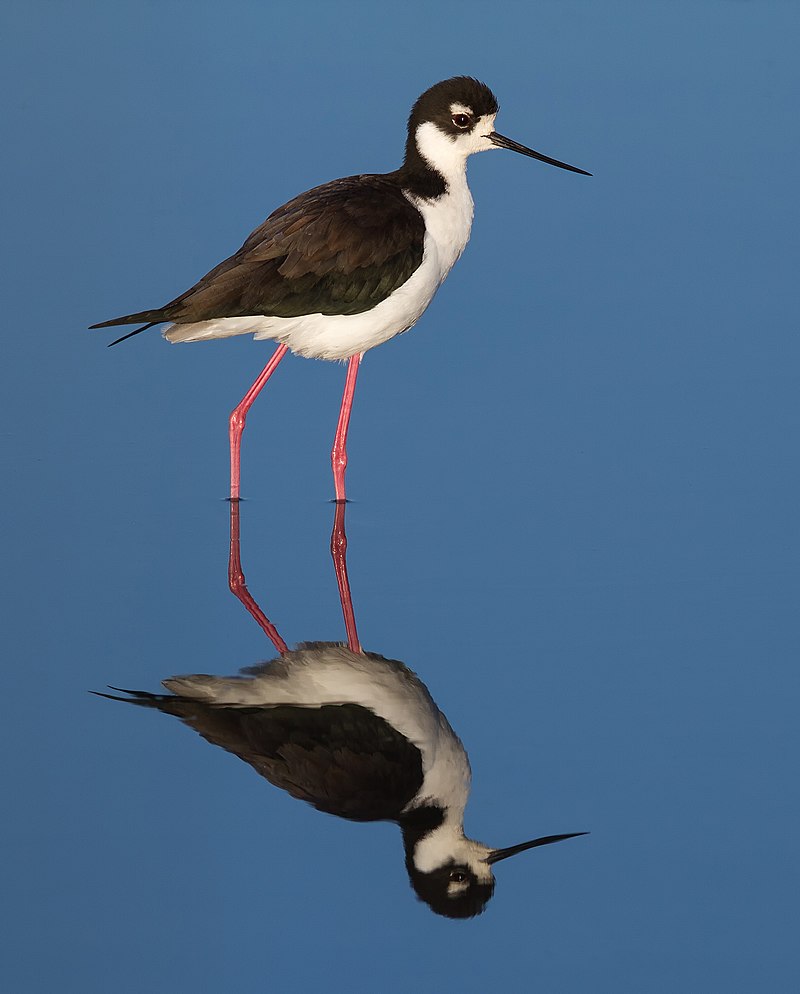
The Black-necked Stilt is an elegant shorebird that can be found from the coastal areas of California to Florida, then south through Central America and Brazil.
It has black upperparts contrasted by long white wings with a glossy sheen. Its striking red eyes are set against its white facial mask, while its legs are bright pinkish.
The Haematopus mexicanus species inhabits marshy wetlands and brackish lagoons where it feeds on insects, crustaceans, small amphibians, and fish, which they catch using their slender bill or chase after them as they run across the surface of water or mudflats.
This bird typically nests near shallow waters but will use any habitat type if food resources are available nearby, making it a highly adaptable species well suited for human-altered habitats such as rice fields and sewage ponds.
Scientific classification:
| Kingdom | Animalia |
| Phylum | Chordata |
| Class | Aves |
| Order | Charadriiformes |
| Family | Recurvirostridae |
| Genus | Himantopus |
| Species | H. mexicanus |
Also Featured In: Phoenix Birds You Should Know, Most Common Oahu Birds
14. Loggerhead Shrike
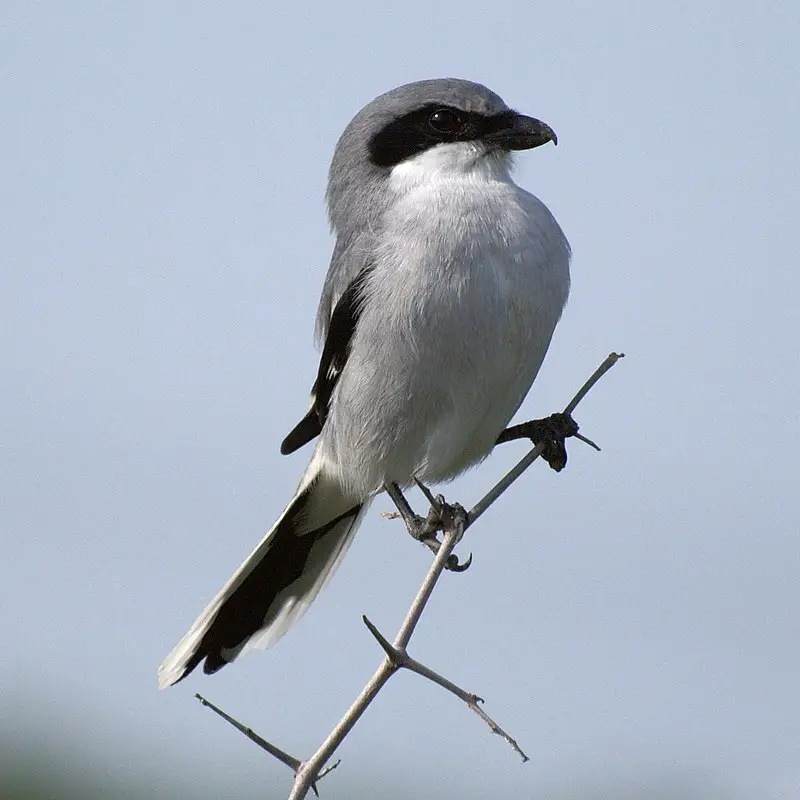
The Loggerhead Shrike is a carnivorous bird found only in North America. It belongs to the family Laniidae and is known as the “butcherbird” because of its habit of catching prey, such as amphibians, insects, lizards, and small mammals.
The shrike has a black mask around its eyes and grey wings with white patches on them.
Its back is black with white spots resembling stars or snowflakes; some may have brown feathers instead of black ones.
This species feeds mainly by perching from elevated locations like bushes or trees where it can spot potential meals below it before diving down for capture.
Interestingly, these birds are also known to store their food by impaling it onto thorns, which they use later when hungry.
With less than 2 million estimated population left in the wild today, this species needs our help, so we should do whatever we can to protect them better.
Scientific classification:
| Kingdom | Animalia |
| Phylum | Chordata |
| Class | Aves |
| Order | Passeriformes |
| Family | Laniidae |
| Genus | Lanius |
| Species | L. ludovicianus |
Also Featured In: Top Birds Found in Mexico, Common Birds in Alberta
15. White-Faced Ibis
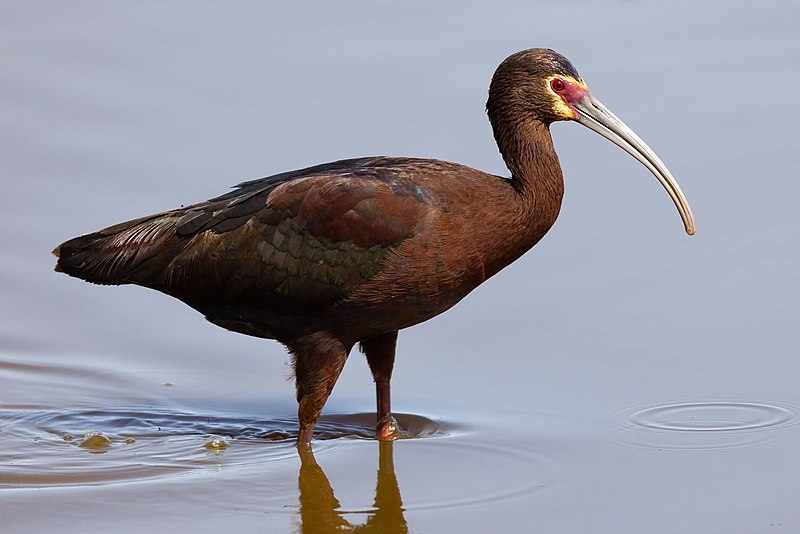
The White-faced Ibis is a species of wading bird belonging to the ibis family. It breeds in marshes, nesting on low trees or bushes.
The breeding range for this species stretches from the western United States south through Mexico, southeastern Brazil, and Bolivia down to central Argentina and along the coast of Chile.
Its wintering grounds include coastal California, northern Arizona, New Mexico, and Central America, occasionally occurring further north than usual due to favorable conditions.
This beautiful bird has white plumage with bronze wings that shine when seen under sunlight. Furthermore, its head is adorned by an unmistakable white face patch, which gives it its name—White-faced Ibis.
Scientific classification:
| Kingdom | Animalia |
| Phylum | Chordata |
| Class | Aves |
| Order | Pelecaniformes |
| Family | Threskiornithidae |
| Genus | Plegadis |
| Species | P. chihi |
Also Featured In: Most Common Oaxaca Birds, Birds that Live in Tabasco
16. Great Blue Heron
The Great Blue Heron is a majestic wading bird found in many parts of North America, Central America, the Caribbean, and even as far away as the Galapagos Islands.
It has an impressive wingspan which can reach up to six feet wide. Its feathers are mainly bluish-gray with brownish streaks on its neck and chest, while its head displays white plumes.
The adult herons can also be identified by their yellow bill and legs.
They live near bodies of water such as lakes, marshes, or rivers, feeding on fish using a spear-like motion with their sharp bills.
An all-white population exists only in South Florida and the Florida Keys, making it unique.
Scientific classification:
| Kingdom | Animalia |
| Phylum | Chordata |
| Class | Aves |
| Order | Pelecaniformes |
| Family | Ardeidae |
| Genus | Ardea |
| Species | A. herodias |
Also Featured In: Common Birds in Canada, Blue Birds You’ll Found around Us
17. Red-Naped Sapsucker
The Red-naped Sapsucker is a medium-sized woodpecker native to North America. It was initially considered a subspecies of the yellow-bellied sapsucker, but it has since been identified as its species.
This bird belongs to the genus Sphyrapicus and has no known subspecies. Its distinct red head patch makes this species easy to identify among other birds.
It can usually be found near conifers or deciduous trees that contain sap wells drilled by these birds for their food source – mainly insects and tree sap.
These birds eat fruits, berries, and nuts during winter when bug populations decrease significantly.
The Red-naped Sapsucker is an important part of many ecosystems across North America due to their unique diet habits, which provide essential nutrients needed for plant growth and health, making them a valuable asset in preserving forests everywhere.
Scientific classification:
| Kingdom | Animalia |
| Phylum | Chordata |
| Class | Aves |
| Order | Piciformes |
| Family | Picidae |
| Genus | Sphyrapicus |
| Species | S. nuchalis |
Also Featured In: Woodpeckers Species, Birds that Found in the Yellowstone
18. Rough-Legged Buzzard
The Rough-legged Buzzard, also known as the Rough-legged Hawk, is a medium to large bird of prey that inhabits Arctic and Subarctic regions in North America, Europe, and Russia.
It migrates south during winter. These majestic birds build their nests on cliffs or other rocky ledges, making them difficult to spot from afar.
Depending on seasonality, their plumage can be either dark brown or light with barred underparts and a white head.
They have long wings, which help them cover incredible distances while migrating, but they are by no means fast flyers – preferring soaring flight patterns where possible instead.
The primary diet for these raptors consists of small rodents such as voles and lemmings; however, they will take larger prey if needed (such as grouse).
Scientific classification:
| Kingdom | Animalia |
| Phylum | Chordata |
| Class | Aves |
| Order | Accipitriformes |
| Family | Accipitridae |
| Genus | Buteo |
| Species | B. lagopus |
Also Featured In: birds of Massachusetts, Most Common Romanian Birds
19. Horned Lark
The Horned Lark, known as the Shore Lark in Europe and North America, is a lark species belonging to the Alaudidae family.
It can be found across the northern hemisphere and has been classified under its Latin name, Eremophila alpestris, which means “of high mountains,” referring to its prevalence in mountainous areas like the Alps.
This bird is distinguished by two black tufts or ‘horns’ on either side of its head. Its size varies from 11-13 cm long, with brown upperparts and pale whitish underparts sporting darker streaks throughout them both.
With an adaptation for ground nesting, it builds nests out of grasses lined with feathers near open fields where food sources are abundant such as insects, grains and seeds giving this species great potential for survival even when conditions may become harsh during winter months.
Scientific classification:
| Kingdom | Animalia |
| Phylum | Chordata |
| Class | Aves |
| Order | Passeriformes |
| Family | Alaudidae |
| Genus | Eremophila |
| Species | E. alpestris |
Also Featured In: birds of Vermont, Ukrainian Birds You Should Know
20. Long-Billed Curlew
The Long-billed Curlew is an impressive shorebird, 50 to 65 cm in length and boasting a bill that can be up to 10cm long – hence its name
This species breeds in North America’s central and western areas before migrating south for winter.
Its distinctive call has earned it nicknames like “sickle bird” or “candlestick bird.” They are omnivorous, eating insects, spiders, and plants on land and in the water.
In addition, they have also been known to scavenge carrion from time to time.
These magnificent birds inhabit coastal regions such as mudflats, marshes, and beaches, making them easy enough to spot if you know their habitat.
Scientific classification:
| Kingdom | Animalia |
| Phylum | Chordata |
| Class | Aves |
| Order | Charadriiformes |
| Family | Scolopacidae |
| Genus | Numenius |
| Species | N. americanus |
Also Featured In: birds of Idaho, Birds that Live in the Grasslands
21. American Kestrel
The American kestrel, also known as the sparrow hawk, is a popular falcon species in North America. The smallest falcon can come in different sizes based on subspecies and sex.
Its weight ranges from that of a blue jay to a mourning dove. In addition to North America, this bird species is also found in South America.
There are 17 subspecies of American kestrels, each adapted to different environments.
Although small, the American kestrel is a fierce predator, often preying on insects, rodents, and other small birds.
Its impressive hunting skills and stunning coloration make it a favorite among birdwatchers and falconers.
Scientific classification:
| Kingdom | Animalia |
| Phylum | Chordata |
| Class | Aves |
| Order | Falconiformes |
| Family | Falconidae |
| Genus | Falco |
| Species | F. sparverius |
Also Featured In: Birds That Live in Colorado, Birds that Live in the Deserts
22. Northern Harrier
The Northern harrier, also known as the marsh hawk or ring-tailed hawk, is a bird of prey that can be found breeding in the northern parts of the northern hemisphere in Canada and the northernmost USA.
During winter, they migrate to more southerly areas, with breeding birds moving to the southernmost USA, Mexico, and Central America.
This hawk has a distinctive white rump patch visible during flight, making it easy to spot.
It is known for its unique hunting behavior, as it searches for prey by flying low over fields and marshes, using its incredible hearing to detect prey beneath the surface.
The Northern harrier feeds on small mammals, birds, and even insects.
They are ecologically and culturally important and are a common sight for bird watchers in their respective habitats.
Scientific classification:
| Kingdom | Animalia |
| Phylum | Chordata |
| Class | Aves |
| Order | Accipitriformes |
| Family | Accipitridae |
| Genus | Circus |
| Species | C. hudsonius |
Also Featured In: Most Common Lake Birds, Birds that can be Seen in Outer Banks
23. Wilson’s Phalarope
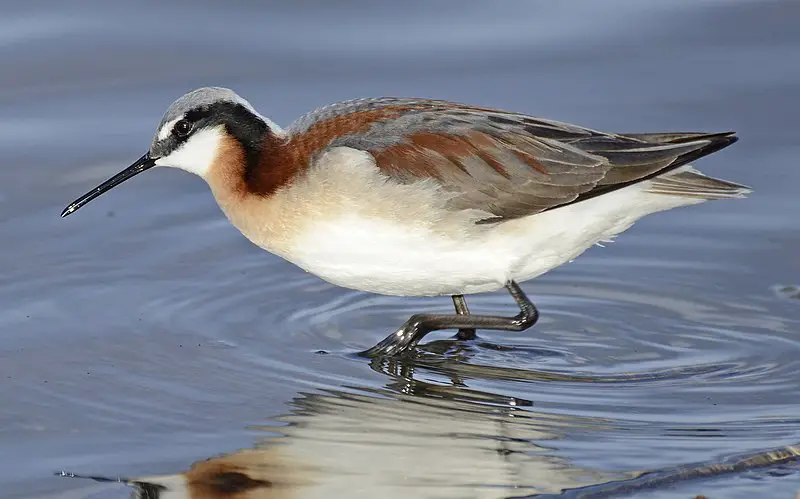
The Wilson’s phalarope is a relatively small species of wading bird native to North America. It is known for being the largest of the phalaropes and living in the prairies of western Canada and the western United States.
During migration, the Wilson’s phalarope travels through Central America during March/April and September/October. It winters near the Andes in Argentina, where it can be found near inland salt lakes.
While not particularly common, the species is a good example of the unique wildlife found in North America.
Scientific classification:
| Kingdom | Animalia |
| Phylum | Chordata |
| Class | Aves |
| Order | Charadriiformes |
| Family | Scolopacidae |
| Genus | Phalaropus |
| Species | P. tricolor |
Also Featured In: Common Birds of Antelope Island State Park,
24. Northern Shoveler
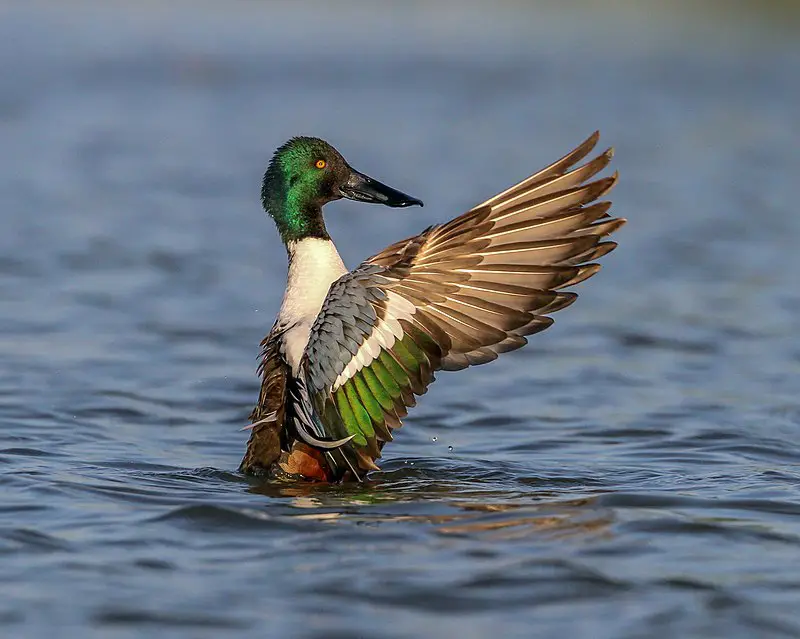
The Northern Shoveler, also known as the Shoveler, is a widely distributed and common duck. It breeds in northern regions of Europe and across much of North America.
It can be found in various locations in the winter months, including southern Europe, the Indian subcontinent, Southeast Asia, Central, the Caribbean, and northern South America.
This duck is rarely seen in Australia. The Northern Shoveler is easily identifiable by its large, spoon-shaped bill, which it uses to filter small organisms from the water. It is a dabbling duck that feeds on seeds and aquatic plants.
The male Shoveler has striking plumage with a green head, white breast, chestnut sides, and black tail. Females are more subdued in color with mottled brown feathers.
The Northern Shoveler is a fascinating bird with unique physical features and a wide distribution range.
Scientific classification:
| Kingdom | Animalia |
| Phylum | Chordata |
| Class | Aves |
| Order | Anseriformes |
| Family | Anatidae |
| Genus | Spatula |
| Species | S. clypeata |
Also Featured In: Birds That Live around Grand Turk Island,
Conclusion
Antelope Island boasts a rich and diverse bird species, offering birdwatchers and nature enthusiasts a unique opportunity to observe and appreciate the beauty of these often lesser-known avian inhabitants.
From the Chukar Partridge’s striking plumage to the Western Grebe’s graceful flight, each species contributes to the island’s ecological tapestry.
By exploring and learning about these birds, visitors can better understand the island’s ecosystem and the importance of conservation efforts to protect its biodiversity for future generations to enjoy.